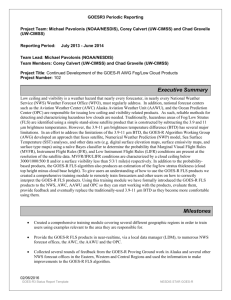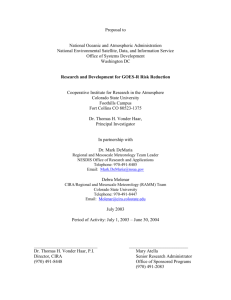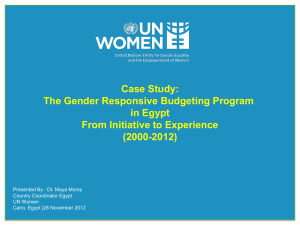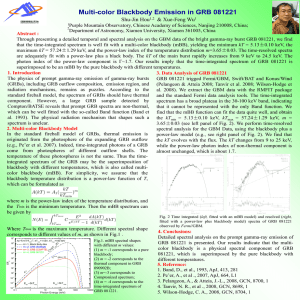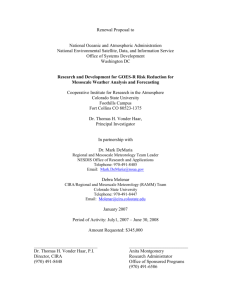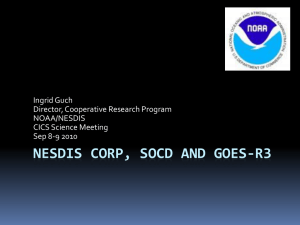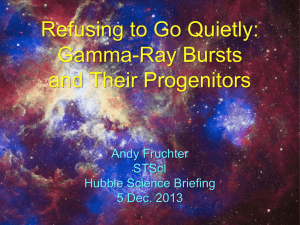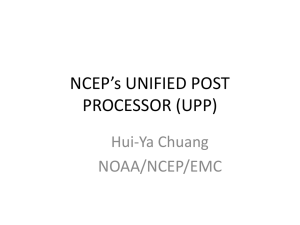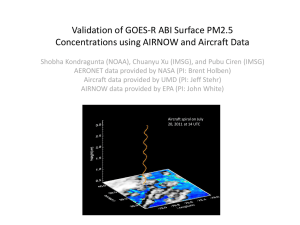View ePoster - 2015 AGU Fall Meeting
advertisement
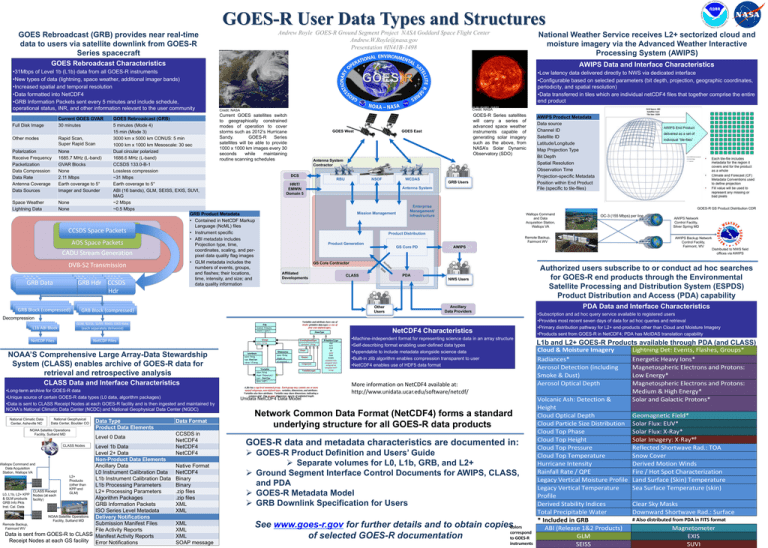
GOES-R User Data Types and Structures Andrew Royle GOES-R Ground Segment Project NASA Goddard Space Flight Center Andrew.W.Royle@nasa.gov Presentation #IN41B-1498 GOES Rebroadcast (GRB) provides near real-time data to users via satellite downlink from GOES-R Series spacecraft National Weather Service receives L2+ sectorized cloud and moisture imagery via the Advanced Weather Interactive Processing System (AWIPS) GOES Rebroadcast Characteristics AWIPS Data and Interface Characteristics •31Mbps of Level 1b (L1b) data from all GOES-R instruments •New types of data (lightning, space weather, additional imager bands) •Increased spatial and temporal resolution •Data formatted into NetCDF4 •GRB Information Packets sent every 5 minutes and include schedule, operational status, INR, and other information relevant to the user community Current GOES GVAR 30 minutes Full Disk Image Other modes Polarization Receive Frequency Packetization Data Compression Data Rate Antenna Coverage Data Sources Space Weather Lightning Data GRB Data GRB GRBData Data •Low latency data delivered directly to NWS via dedicated interface •Configurable based on selected parameters (bit depth, projection, geographic coordinates, periodicity, and spatial resolution) •Data transferred in tiles which are individual netCDF4 files that together comprise the entire end product Credit: NASA Credit: NASA Current GOES satellites switch to geographically constrained modes of operation to cover storms such as 2012’s Hurricane Sandy. GOES-R Series satellites will be able to provide 1000 x 1000 km images every 30 seconds while maintaining routine scanning schedules GOES-R Series satellites will carry a series of advanced space weather instruments capable of generating solar imagery such as the above, from NASA’s Solar Dynamic Observatory (SDO) GOES Rebroadcast (GRB) 5 minutes (Mode 4) 15 min (Mode 3) Rapid Scan, 3000 km x 5000 km CONUS: 5 min Super Rapid Scan 1000 km x 1000 km Mesoscale: 30 sec None Dual circular polarized 1685.7 MHz (L-band) 1686.6 MHz (L-band) GVAR Blocks CCSDS 133.0-B-1 None Lossless compression 2.11 Mbps ~31 Mbps Earth coverage to 5° Earth coverage to 5° Imager and Sounder ABI (16 bands), GLM, SEISS, EXIS, SUVI, MAG None ~2 Mbps None ~0.5 Mbps GRB Product Metadata • Contained in NetCDF Markup Language (NcML) files CCSDS Space Packets • Instrument specific • ABI metadata includes AOS Space Packets Projection type, time, coordinates, scaling, and perCADU Stream Generation pixel data quality flag images • GLM metadata includes the DVB-S2 Transmission numbers of events, groups, and flashes; their locations, time, intensity, and size; and GRB Hdr CCSDS GRB Hdr CCSDS GRB Hdr CCSDS data quality information GOES-R GS Product Distribution CDR Wallops Command and Data Acquisition Station, Wallops VA Remote Backup, Fairmont WV GRB Block (compressed) GRB Block GRB Block(compressed) (compressed) GLM, SEISS, SUVI, MAG, EXIS data (each separately delivered) NetCDF Files NetCDF4 Characteristics •Machine-independent format for representing science data in an array structure •Self-describing format enabling user-defined data types •Appendable to include metadata alongside science data •Built-in zlib algorithm enables compression transparent to user •NetCDF4 enables use of HDF5 data format NetCDF Files NOAA’S Comprehensive Large Array-Data Stewardship System (CLASS) enables archive of GOES-R data for retrieval and retrospective analysis CLASS Data and Interface Characteristics •Long-term archive for GOES-R data •Unique source of certain GOES-R data types (L0 data, algorithm packages) •Data is sent to CLASS Receipt Nodes at each GOES-R facility and is then ingested and maintained by NOAA’s National Climatic Data Center (NCDC) and National Geophysical Data Center (NGDC) National Climatic Data Center, Asheville NC National Geophysical Data Center, Boulder CO NOAA Satellite Operations Facility, Suitland MD CLASS Nodes Data Type Product Data Elements Level 0 Data Level 1b Data Level 2+ Data Non-Product Data Elements Wallops Command and Ancillary Data Data Acquisition Station, Wallops VA L0 Instrument Calibration Data L2+ L1b Instrument Calibration Data Products (other than L1b Processing Parameters KPP and CLASS Receipt L2+ Processing Parameters GLM) L0, L1b, L2+ KPP Nodes (at each Algorithm Packages & GLM products facility) GRB Info Pkts GRB Information Packets Inst. Cal. Data ISO Series Level Metadata NOAA Satellite Operations Delivery Notifications Facility, Suitland MD Submission Manifest Files Remote Backup, Fairmont WV File Activity Reports Data is sent from GOES-R to CLASS Manifest Activity Reports Receipt Nodes at each GS facility Error Notifications AWIPS Network Control Facility, Silver Spring MD AWIPS Backup Network Control Facility, Fairmont, WV Distributed to NWS field offices via AWIPS PDA Data and Interface Characteristics Decompression L1b ABI Block L1b ABI L1b ABIBlock Block OC-3 (155 Mbps) per line Authorized users subscribe to or conduct ad hoc searches for GOES-R end products through the Environmental Satellite Processing and Distribution System (ESPDS) Product Distribution and Access (PDA) capability Hdr Hdr Hdr GRB Block (compressed) GRB Block GRB Block(compressed) (compressed) AWIPS Product Metadata Data source Channel ID Satellite ID Latitude/Longitude Map Projection Type Bit Depth Spatial Resolution Observation Time Projection-specific Metadata Position within End Product File (specific to tile-files) Data Format CCSDS in NetCDF4 NetCDF4 NetCDF4 Native Format NetCDF4 Binary Binary .zip files .zip files XML XML XML XML XML SOAP message More information on NetCDF4 available at: http://www.unidata.ucar.edu/software/netcdf/ Unidata NetCDF4 Data Model Network Common Data Format (NetCDF4) forms a standard underlying structure for all GOES-R data products GOES-R data and metadata characteristics are documented in: GOES-R Product Definition and Users’ Guide Separate volumes for L0, L1b, GRB, and L2+ Ground Segment Interface Control Documents for AWIPS, CLASS, and PDA GOES-R Metadata Model GRB Downlink Specification for Users See www.goes-r.gov for further details and to obtain copiesColors correspond of selected GOES-R documentation to GOES-R instruments •Subscription and ad hoc query service available to registered users •Provides most recent seven days of data for ad hoc queries and retrieval •Primary distribution pathway for L2+ end-products other than Cloud and Moisture Imagery •Products sent from GOES-R in NetCDF4; PDA has McIDAS translation capability L1b and L2+ GOES-R Products available through PDA (and CLASS) Cloud & Moisture Imagery Lightning Det: Events, Flashes, Groups* PDA Interface Characteristics (KPP) Radiances* Heavy Ions* •Low latency distribution for all GOES-R EndEnergetic Products Aerosol Detection (including •Subscription and ad hoc query capability Magnetospheric Electrons and Protons: •Application Programming Interface for usersLow Energy* Smoke & Dust) •Limited to authorized NOAA users Aerosol Optical Depth Magnetospheric Electrons and Protons: •Data in NetCDF format; translation capability to McIDAS Medium & High Energy* Volcanic Ash: Detection & Solar and Galactic Protons* Height Cloud Optical Depth Geomagnetic Field* Cloud Particle Size Distribution Solar Flux: EUV* Cloud Top Phase Solar Flux: X-Ray* Cloud Top Height Solar Imagery: X-Ray*# Cloud Top Pressure Reflected Shortwave Rad.: TOA Cloud Top Temperature Snow Cover Hurricane Intensity Derived Motion Winds Rainfall Rate / QPE Fire / Hot Spot Characterization Legacy Vertical Moisture Profile Land Surface (Skin) Temperature Legacy Vertical Temperature Sea Surface Temperature (skin) Profile Derived Stability Indices Clear Sky Masks Total Precipitable Water Downward Shortwave Rad.: Surface # Also distributed from PDA in FITS format * Included in GRB ABI (Release 1&2 Products) Magnetometer GLM EXIS SEISS SUVI
